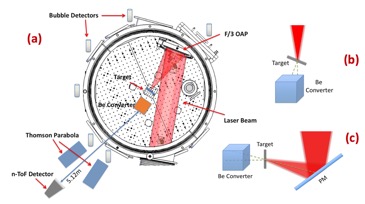
Posted: 4/9/16
Author: Steven
Topic: Neutron
Ion driven neutron source experiment on Texas Petawatt Laser(TPW)3
We had our ion based neutron test on TPW. TPW is a much stronger laser than UT3. The chamber layout was shown in figure a. Here, a 150J laser with 150fs pulse focus on thin foil target via F/3 OAP. Neutrons were produced by radiating the laser-accelerated ions into a 5 cm Beryllium cube. A neutron Time of Flight (n-TOF) detector was set up 5.1 meters away from the target. The laser driven gamma rays was used to trigger the oscilloscope and served as a time reference, which was latter deducted from the neutron signal by using exponential decay model that resulted from the decay time (14 ns) of the scintillator. An array of nine bubble detectors was set around the target camber to determine the neutron flux at various angles. Two Thomson Parabola (TP) were set up to measure the ion energies and spices at different angles. One is towards the laser direction, the other is toward target normal direction. Two different configuration was used in this experiment, one is without Plasma Mirror (PM), the other is with PM, as shown in Figure b and c.
During the campaign, deuterized plastic (CD2) targets of different thickness, 2 μm gold foils and Diamond like Carbon (DLC) targets were used in generating neutron. PM was used to increase the contrast ratio of the laser profile, which presumed to increase the energy conversion and maximum energy acquired by ions in Break Out Afterburner (BOA) regime. Ions with higher energy should then increase the neutron yield. Data was recorded both before and after the PM was mounted. Nine legible neutron shots were acquired, five of which corresponded to 2 μm gold with PM, one to CD2 without PM, and one to DLC and two to CD with PM. For CD2 targets, deuterons and protons were accelerated. Neutrons were produced via the nuclear reactions 9Be(d,n), 9Be(p,n) and by the deuteron breakup reaction. Although the neutron energy and flux were similar to the result from previous experiment, isotropic neutron flux was observed for CD2 target and non-isotropic flux with more forward neutron was observed for gold targets, which are not observed in the previous research [1]. In addition, neutrons from gold targets shot has higher neutron yield and much higher energy than the thinner CD2, which was unexpected. The neutron energy spread from 1~50 MeV, and for most shot it peaks at 10 MeV. For gold targets, neutron energy were up to 20 MeV.
We got 2x1010 neutron per shot in this experiment, which corresponding to flux number of 5x1018 n/s or 5x1016 n/cm2/s (flux at the surface of converter). The neutron flux did not change a lot for CD2 target. Neutron energy and flux were higher for DLC target. In our experiment, higher neutron flux usually came with higher energy distribution.; But this might not be a conclusive conclusion due to our limited shot number. For future analysis, GEANT4 simulation will be used to simulate the process by using the data from ion measurement.